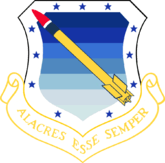11th Air Division
The 11th Air Division was an air division of the United States Air Force. It provided for the air defense of northern Alaska and supervised base operations at major and minor installations in that area. It furnished detachments at Ice Station Alpha, Drift Station Charlie (November 1957–August 1960), and Drift Station Bravo (T-3) (Fletcher's Ice Island) (July 1959–August 1960), in the Arctic Ocean."[1]
| 11th Air Division (Defense) | |
|---|---|
| Active | 1950–1951; 1953–1960 |
| Country | |
| Branch | |
| Role | Command of air defense forces |
| Equipment | see "Aircraft / Missiles / Space vehicles" section below |
| Decorations | see "Lineage and honors" section below |
| Insignia | |
| 11th Air Division emblem |  |
Lineage
- Established as the 11th Air Division (Defense) on 24 October 1950
- Organized on 1 November 1950
- Discontinued on 27 April 1951 (as a Table of Distribution (T/D) unit)
- Activated on 27 April 1951 (as a Table of Organization unit)
- Inactivated on 20 July 1951
- Activated on 8 April 1953
- Discontinued and inactivated on 25 August 1960[1]
The discontinuation and activation in April 1951 represents a change by the division's headquarters from a Table of Distribution unit to a Table of Organization unit. See List of MAJCOM wings of the United States Air Force
Emblem
A shield variegated azure (shades of blue) within a border argent, charged with eleven stars of blue, over all in bend a rocket or, tipped red, white and blue[1]
Assignments
- Alaskan Air Command, 1 November 1950 – 27 April 1951
- Alaskan Air Command, 27 April 1951 – 20 July 1951
- Alaskan Air Command, 8 April 1953 – 25 August 1960[1]
Components
- Squadrons
- 18th Fighter-Interceptor Squadron: 1 September 1954 – 20 September 1954; 1 October 1955 – 20 August 1957
- 72d Fighter-Bomber Squadron: attached 1 September 1953 – 15 September 1953
- 416th Fighter-Bomber Squadron: attached 15 September 1953 – 29 September 1953
- 433d Fighter-Interceptor Squadron: 14 July 1954 – 20 September 1954; 1 October 1955 – 1 November 1957 (not operational after 10 September 1957)
- 449th Fighter-All Weather Squadron (later 449th Fighter Interceptor Squadron): attached c. January 1951 – 20 July 1951; assigned 8 April 1953 – 20 September 1954; 1 October 1955 – 25 August 1960
- 455th Fighter-Bomber Squadron: 8 August 1955 – 22 November 1955
- 531st Fighter-Bomber Squadron: attached 5 October 1953 – 13 October 1953
- 720th Fighter-Bomber Squadron: 25 December 1953 – 8 August 1955[1]
Stations
- Ladd Air Force Base, Alaska, 1 November 1950 – 27 April 1951
- Ladd Air Force Base, Alaska, 27 April 1950 – 20 July 1951
- Ladd Air Force Base, Alaska, 8 April 1953 – 25 August 1960[1]
Aircraft / Missiles / Space vehicles
- North American F-82 Twin Mustang, 1951
- Lockheed F-94 Starfire, 1951, 1953-1954
- Douglas C-47 Skytrain, 1953-c. 1956
- Douglas C-54 Skymaster, 1953-c. 1956
- Fairchild C-119 Flying Boxcar, 1953-c. 1954
- de Havilland Canada L-20 Beaver, 1953-c. 1956
- Northrop F-89 Scorpion, 1954–1960
- Fairchild C-123 Provider, 1957-1960[1]
Commanders
- Brigadier General David H. Baker, 1 November 1950 – c.20 July 1951 (additional duty, 1 November 1950–c. January 1951).
- Brigadier General Donald B. Smith, 8 April 1953
- Colonel Oscar A. Heinlein, c. July 1954
- Brigadier General T. Alan Bennett, 28 August 1954
- Colonel Lewis W. Stocking, c.15 May 1957
- Brigadier General Kenneth H. Gibson, c. July 1957
- Brigadier General Conrad F. Necrason, 11 September 1957
- Brigadier General Gordon H. Austin, by September 1958 – 25 August 1960[1]
References
Notes
- "Factsheet 11 Air Division (Defense)". Air Force Historical Research Agency. October 4, 2007. Archived from the original on 2012-10-30. Retrieved April 9, 2014.
Bibliography
![]()
- Maurer, Maurer, ed. (1982) [1969]. Combat Squadrons of the Air Force, World War II (PDF) (reprint ed.). Washington, DC: Office of Air Force History. ISBN 0-405-12194-6. LCCN 70605402. OCLC 72556.